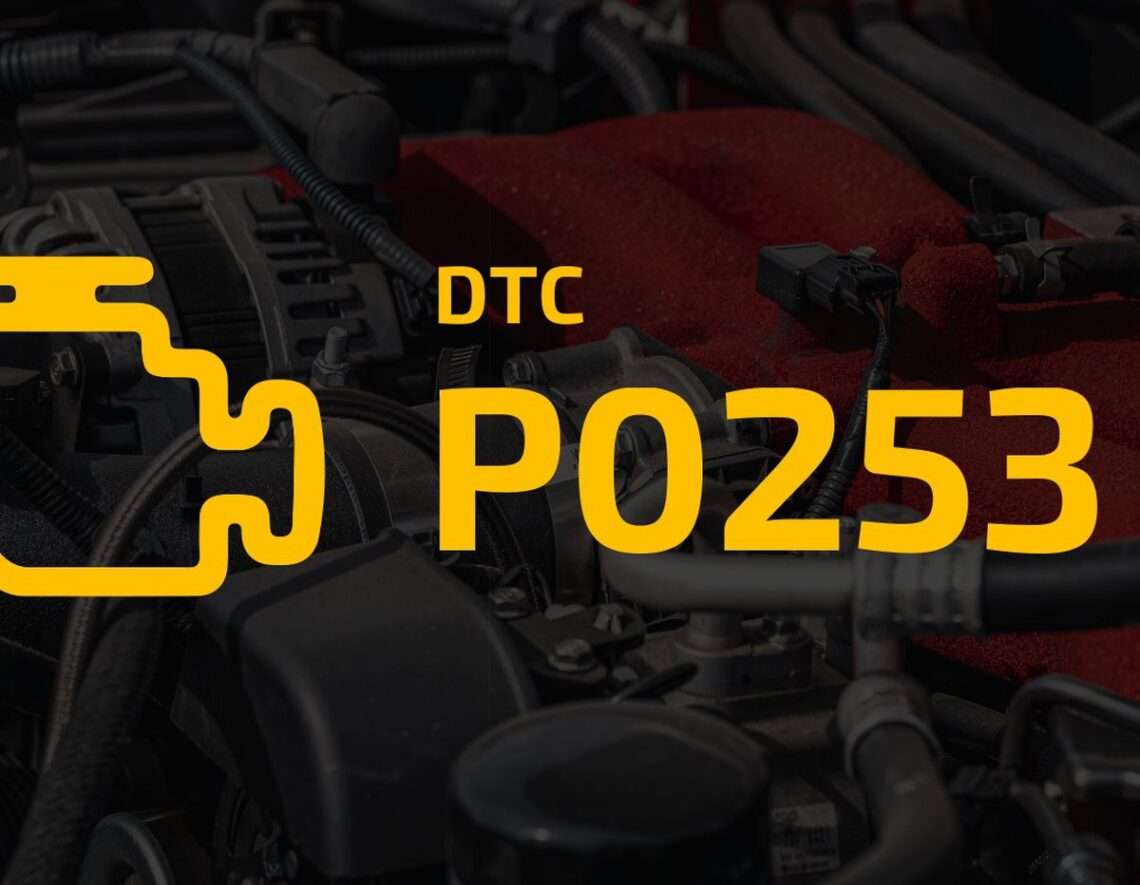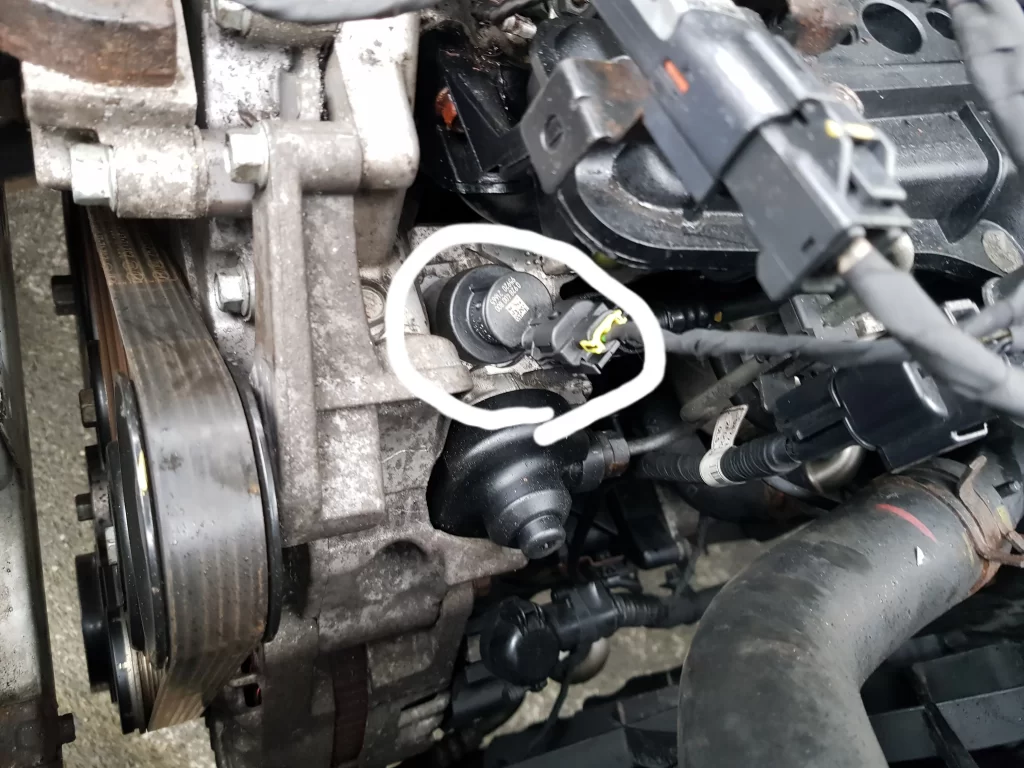
P0253 Low signal level in the control circuit of the fuel metering pump "A" (cam/rotor/injector)
Content
P0253 – OBD-II Trouble Code Technical Description
Trouble code P0253 indicates that the fuel metering pump "A" control circuit (cam/rotor/injector) is too low.
What does the fault code mean P0253?
Trouble code P0253 indicates a problem with the fuel management system on diesel engines. It indicates that the engine control module (PCM) has detected a discrepancy between the voltage signal supplied to the electronic fuel control actuator and the voltage signal returned back from the fuel metering unit. This may be due to insufficient or excessive fuel pressure being supplied to the fuel system.

Possible reasons
Trouble code P0253 can be caused by various reasons:
- Malfunction of the electronic fuel control drive: Problems with the electronic drive itself, which regulates the fuel supply, can cause this code to appear.
- Problems with the fuel dispenser: Malfunctions in the fuel metering unit, which is responsible for accurately dispensing fuel, can cause the P0253 code to appear.
- Incorrect voltage or resistance in the electrical circuit: Problems with the wiring, connectors, or connections between the electronic fuel control actuator and the PCM can cause signal inconsistencies and cause this error to appear.
- Problems with fuel pressure sensors or sensors: Malfunctions in the sensors responsible for measuring the fuel pressure in the system can lead to improper operation of the fuel control system.
- Problems with the PCM or other electronic components: Faults in the PCM itself or other electronic components related to the engine management system can also cause the P0253 code to appear.
These are just some of the possible causes, and to accurately determine the cause, it is necessary to conduct a detailed diagnosis of the vehicle using specialized equipment.
What are the symptoms of a fault code? P0253?
Symptoms that may occur when DTC P0253 is present may include the following:
- Loss of engine power: There may be a loss of power when accelerating or while driving.
- Unstable engine operation: The engine may experience rough, shaking, shaking, or rough idling.
- Difficulty starting the engine: If there is an irregularity in the fuel supply, it may be difficult to start the engine, especially during a cold start.
- Deteriorating fuel economy: A P0253 code may cause poor fuel economy because the fuel management system is not operating correctly.
- Increased emissions: Imperfect combustion of fuel due to improper supply may lead to increased emissions of harmful substances in the exhaust gases.
- Errors appearing on the dashboard: Depending on the specific engine management system, a “Check Engine” warning light or other lights may appear to indicate problems with the fuel system.
These symptoms may occur in varying degrees and may depend on the specific cause of the problem. If you notice these symptoms, it is recommended that you contact a qualified auto mechanic for diagnosis and repair.
How to diagnose a fault code P0253?
Diagnosis for DTC P0253 includes the following:
- Checking the error code: Use the OBD-II diagnostic scanner to read the error code from the vehicle's ECU (Electronic Control Unit).
- Checking electrical connections: Check all electrical connections connecting the electronic fuel control actuator to the PCM. Make sure connections are secure, there are no signs of corrosion or oxidation, and there are no breaks or damage to the wiring.
- Checking the fuel dispenser: Check the condition and functionality of the fuel dispenser. This may include checking winding resistance, fuel distribution mechanism function, etc.
- Checking the electronic fuel control drive: Check the electronic drive for faults. Make sure it is functioning properly and receiving and transmitting signals as required.
- Checking fuel pressure sensors: Check the condition and correct operation of the fuel pressure sensors. Make sure they provide correct PCM data.
- PCM Software Check: In case all other components appear normal, the problem may be related to the PCM software. In this case, the PCM may need to be updated or reprogrammed.
- Additional checks: Perform additional checks as necessary, including checking for external factors such as damaged wiring or components, corroded connectors, etc.
After completing the above steps, the problem should be identified. If you are unsure of the diagnostic results or cannot resolve the malfunction yourself, it is recommended that you contact a qualified auto mechanic or auto service center for further diagnosis and repair.
Diagnostic errors
When diagnosing DTC P0253, the following errors may occur:
- Skip checking electrical connections: Improperly or incompletely performing electrical inspections may result in an electrical problem being missed and an incorrect diagnosis.
- Misinterpretation of data: Incorrect reading or interpretation of data received from the diagnostic scanner or other tools may result in the cause of the error being incorrectly determined.
- Skipping Major Component Diagnostics: Some major components, such as the fuel meter, electronic fuel control actuator, fuel pressure sensors, etc., may be missed during diagnosis, which may make it difficult to find the cause of the error.
- Unaccounted external factors: Some external factors, such as damaged wiring, corroded connectors, or environmental conditions affecting fuel system operation, may be missed during diagnosis.
- Neglect of diagnostic sequence: Failure to follow the correct diagnostic sequence or skip certain steps may result in missing important details and incorrectly identifying the cause of the error.
- Inadequacy of experience or knowledge: Lack of experience or knowledge in vehicle diagnostics, especially diesel engines, can lead to errors when diagnosing the P0253 code.
For successful diagnosis, you must carefully follow diagnostic procedures and techniques, as well as have sufficient experience and knowledge in the field of automotive repair and electronics. If doubts or difficulties arise, it is recommended to contact professionals.
How serious is the fault code? P0253?
Trouble code P0253 can be serious because it indicates a problem with the fuel management system on diesel engines. Faults in this system can lead to a number of problems:
- Loss of power and efficiency: Improper fuel delivery can cause loss of engine power and reduced engine efficiency. This can affect the vehicle's performance and overall fuel economy.
- Unstable engine operation: Improper mixing of fuel and air can cause engine instability, which may cause the engine to shake, shake, or run rough.
- Difficulty starting the engine: Fuel supply problems may make it difficult to start the engine, especially in cold weather or after a long period of inactivity.
- Increased emissions: Malfunctions in the fuel supply system can lead to an increase in emissions of harmful substances, which can negatively affect the environmental friendliness of the vehicle.
- Engine damage: In case of serious malfunctions, a malfunction in the fuel supply system may cause engine damage.
Due to the potential serious consequences caused by a P0253 trouble code, it is recommended that you have a qualified auto mechanic or auto repair shop diagnose and repair it to avoid further engine problems and keep your vehicle safe and efficient.
What repair will help eliminate the code? P0253?
Resolving the P0253 trouble code may require the following repair actions, depending on the specific cause of the problem:
- Replacement or repair of the fuel dispenser: If the problem is with the fuel dispenser itself, it should be checked for faults and replaced or repaired if necessary.
- Replacing the electronic fuel control drive: If the electronic drive does not function properly, it should be replaced with a new, working one.
- Checking and repairing electrical connections: Check all electrical connections between the electronic fuel control actuator and the PCM for corrosion, oxidation, breaks or other damage. Repair or replace connections as necessary.
- Replacing fuel pressure sensors: If the problem is with the fuel pressure sensors, they should be checked and, if necessary, replaced with good ones.
- Updating or reprogramming the PCM: In case the problem is related to the PCM software, the ECU may need to be updated or reprogrammed.
- Additional renovations: Other repairs may need to be performed, such as replacing or repairing other fuel system or engine components.
When carrying out repair work, you must ensure that the cause of the problem has been correctly identified and carry out a thorough check of the fuel supply system to avoid further problems.
P0253 – Brand-specific information
Trouble code P0253 can occur in various makes of vehicles, especially those with diesel engines. Below are some of them with transcripts:
- Ford:
- P0253: Fuel Injection Pump Fuel Metering Control “A” Low.
- Chevrolet / GMC:
- P0253: Injection Pump Fuel Metering Control “A” Low.
- Dodge / Ram:
- P0253: Injection Pump Fuel Metering Control “A” Low.
- Volkswagen:
- P0253: Injection Pump Fuel Metering Control “A” Low.
- BMW:
- P0253: Injection Pump Fuel Metering Control “A” Low.
- Mercedes-Benz:
- P0253: Injection Pump Fuel Metering Control “A” Low.
- Toyota:
- P0253: Injection Pump Fuel Metering Control “A” Low.
- Audi:
- P0253: Injection Pump Fuel Metering Control “A” Low.
These are just a few examples. The P0253 code can apply to various makes and models of cars, but its meaning is mainly related to problems in the fuel injection system and fuel flow meter “A” control.
One comment
Rafik
P0253